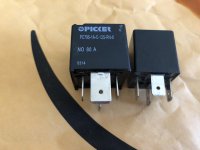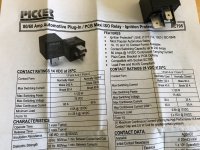You are using an out of date browser. It may not display this or other websites correctly.
You should upgrade or use an alternative browser.
You should upgrade or use an alternative browser.
Glow Plugs...
- Thread starter moship
- Start date
- Views: 11341
More options
Who Replied?
/ Glow Plugs...
#21
The tractor is starting beyond my expectations at this point, but it hasn't been below 20F either.
Two new 80 amp relays with the larger 3/8" tabs for the power side of the relay arrived today. 80 amps is overkill, but that is what I bought off amazon. Picker PC795-1A-C-12S-RN-X at $18.99 for the pair. They are sealed units, with nickel plated tabs and a resistor to protect the voltage spike that occurs when the field collapses.
The stock relay, Panasonic CB-1a-12V ACB33201 utilizes four - 1/4" female tabs with the following dimensions: 0.250 wide by 0.030" thick
The new relay has two-1/4" and two-3/8" tabs that measure 0.368" wide and 0.045 thick.
That's a 50% increase in thickness (0.030" vs 0.045")!!!
Note: Measurements taken with Starrett dial calipers
The thicker tabs should work significantly better with the mating female electrical connectors as they are designed for the wider male tabs.
I don't have time to install at this point, but plan on doing so in the near future. If nothing else I'm going to replace the other relay behind the dash that utilizes the same relay and mating socket to prevent any issues with poor continuity in the future.
The larger plastic housing is NOT an issue. There is plenty of room to accommodate the relay.
Perhaps the pictures will help show the size difference.
Kubota does sell a similar relay at the expected markup over what's available on the open market.
Here's a link to the relays if anyone is interested.
https://www.amazon.com/gp/product/B07GX6SXY2/ref=ox_sc_act_title_1?smid=A16HAOC7J321VG&psc=1
If you have any difficulty starting your tractor in cold weather, I highly recommend trying this type of relay as the thicker tabs should help improve continuity within the relay socket.
Two new 80 amp relays with the larger 3/8" tabs for the power side of the relay arrived today. 80 amps is overkill, but that is what I bought off amazon. Picker PC795-1A-C-12S-RN-X at $18.99 for the pair. They are sealed units, with nickel plated tabs and a resistor to protect the voltage spike that occurs when the field collapses.
The stock relay, Panasonic CB-1a-12V ACB33201 utilizes four - 1/4" female tabs with the following dimensions: 0.250 wide by 0.030" thick
The new relay has two-1/4" and two-3/8" tabs that measure 0.368" wide and 0.045 thick.
That's a 50% increase in thickness (0.030" vs 0.045")!!!
Note: Measurements taken with Starrett dial calipers
The thicker tabs should work significantly better with the mating female electrical connectors as they are designed for the wider male tabs.
I don't have time to install at this point, but plan on doing so in the near future. If nothing else I'm going to replace the other relay behind the dash that utilizes the same relay and mating socket to prevent any issues with poor continuity in the future.
The larger plastic housing is NOT an issue. There is plenty of room to accommodate the relay.
Perhaps the pictures will help show the size difference.
Kubota does sell a similar relay at the expected markup over what's available on the open market.
Here's a link to the relays if anyone is interested.
https://www.amazon.com/gp/product/B07GX6SXY2/ref=ox_sc_act_title_1?smid=A16HAOC7J321VG&psc=1
If you have any difficulty starting your tractor in cold weather, I highly recommend trying this type of relay as the thicker tabs should help improve continuity within the relay socket.
Attachments
Last edited:
LouNY
Super Star Member
- Joined
- Jul 4, 2015
- Messages
- 14,383
- Location
- Greenwich, NY
- Tractor
- Branson 8050, IH 574, Oliver 1550 Diesel Utility (traded in on Branson) NH 8160. Kioti CK2620SECH
I would like to know also.
If you do a google search for DC clamp amp meter you can find several for under $100,
I have an old inductance meter that lays on the wire.
1�� AMP Inductive Generator-Alternator Ammeter - USA Made | Hoyt Meter
FatTire
Veteran Member
- Joined
- Oct 2, 2007
- Messages
- 1,370
- Location
- Colorado
- Tractor
- Kubota L5740, Unimog 404 w/ snowblower, Deere 620i UTV, MX5100 (sold)
I would like to know also.
I have one that was the model prior to this: https://www.amazon.com/dp/B01IB4N3YG/ref=sspa_dk_detail_0?psc=1
Its not as accurate as say, a Fluke, but being able to quickly clamp around a battery cable, or a glow plug lead, can save a lot of time troubleshooting.
I have one that was the model prior to this: https://www.amazon.com/dp/B01IB4N3YG/ref=sspa_dk_detail_0?psc=1
Its not as accurate as say, a Fluke, but being able to quickly clamp around a battery cable, or a glow plug lead, can save a lot of time troubleshooting.
Thanks. I had seen this or similar but was thinking you were referencing a probe that could be used with a DVM.
LouNY
Super Star Member
- Joined
- Jul 4, 2015
- Messages
- 14,383
- Location
- Greenwich, NY
- Tractor
- Branson 8050, IH 574, Oliver 1550 Diesel Utility (traded in on Branson) NH 8160. Kioti CK2620SECH
There are universal probes that can interface with many meters;
TPI A296 AC/DC Amp Current Probe Adapter
similar to this
TPI A296 AC/DC Amp Current Probe Adapter
similar to this


